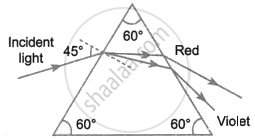Advertisements
Advertisements
Question
In an experiment to trace the path of a ray of light through a glass prism for different values of angle of incidence a student would find that the emergent ray:
(A) is parallel to the incident ray
(B) perpendicular to the incident ray
(C) is parallel to the refracted ray
(D) bends at an angle to the direction of incident ray
Solution
(D)
As the light gets refracted two times at different angles, the emergent ray bends at an angle to the direction of incident ray.
APPEARS IN
RELATED QUESTIONS
State the cause of dispersion of white light passing through a glass prism. How did Newton show that white light of sun contains seven colours using two identical glass prisms. Draw a ray diagram to show the path of light when two identical glass prisms are arranged together in inverted position with respect to each other and a narrow beam of white light is allowed to fall obliquely on one of the focus of the first prism.
Define the term dispersion of white light.
(i) A ray of white light breaks up into its components while passing through a glass prism. Draw a ray diagram to show the path of rays.
(ii) Mark the least deviated colour in your diagram

(iii) Why do different coloured rays deviate differently in a prism?
As light rays emerge from a glass prism into air, are they refracted towards or away from the normal?
The splitting of white light into its constituent colours is called .............
Explain the cause of dispersion of white light through a prism.
A student has to trace the path of a ray of light through a glass prism. List four precautions he should observe for better results.
The periscope is an optical device with a polished surface that reflects the light falling on it.
A ray of light is incident at 45° on an equilateral prism in the diagram below.

- Name the phenomenon exhibited by the ray of light when it enters and emerges out of the prism.
- State the cause of the above phenomenon mentioned by you.
